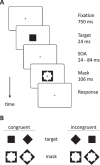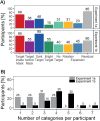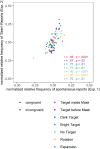Visual experience forms a multidimensional pattern that is not reducible to a single measure: Evidence from metacontrast masking
- PMID: 32181858
- PMCID: PMC7405780
- DOI: 10.1167/jovi.20.3.2
Visual experience forms a multidimensional pattern that is not reducible to a single measure: Evidence from metacontrast masking
Abstract
A metacontrast masking paradigm was employed to provide evidence for the richness and diversity of our visual experience. Square- and diamond-shaped targets were followed by square- and diamond-shaped masks at varying stimulus onset asynchronies (SOAs), resulting in shape-congruent and shape-incongruent trials. In Experiment 1, participants reported in each trial how they perceived target and mask. After extended training, seven different aspects of the target could be distinguished as specific percepts in this metacontrast masking paradigm. These percepts encompass aspects including the temporal distance between both stimuli, the perceived contrast of the target, and motion percepts resulting from the interplay between the target and mask. Participants spontaneously reported each of these percepts, and the frequency of reports varied systematically with SOA and the congruency between target and mask. In Experiment 2, we trained a new group of participants to distinguish each of these target percepts. Again, the frequency of reports of the specific percepts varied with SOA and congruency, just as in Experiment 1. In a last session, we measured objective discrimination performance yielding the typical individually different masking functions across SOAs. An examination of the relation between the frequencies of reports of subjective percepts and objective discrimination performance revealed multiple dissociations between these measures. Results suggest a multidimensional pattern of subjective experiences under metacontrast, which is reflected in dissociated subjective and objective measures of visual awareness. As a consequence, awareness cannot be assessed exhaustively by a single measure, thus challenging the use of simple one-dimensional subjective or objective measures in visual masking.
Figures







Similar articles
-
Individually different weighting of multiple processes underlies effects of metacontrast masking.Conscious Cogn. 2016 May;42:162-180. doi: 10.1016/j.concog.2016.03.006. Epub 2016 Mar 21. Conscious Cogn. 2016. PMID: 27010825
-
Individual differences in subjective experience and objective performance in metacontrast masking.J Vis. 2012 May 25;12(5):5. doi: 10.1167/12.5.5. J Vis. 2012. PMID: 22637706
-
Target-mask shape congruence impacts the type of metacontrast masking.Scand J Psychol. 2011 Dec;52(6):524-9. doi: 10.1111/j.1467-9450.2011.00904.x. Epub 2011 Jul 12. Scand J Psychol. 2011. PMID: 21749401
-
Cortical dynamics of lateral inhibition: metacontrast masking.Psychol Rev. 1997 Jul;104(3):572-94. doi: 10.1037/0033-295x.104.3.572. Psychol Rev. 1997. PMID: 9243965 Review.
-
Metacontrast, target recovery, and the magno- and parvocellular systems: a perspective.Vis Neurosci. 2007 Mar-Apr;24(2):177-81. doi: 10.1017/S0952523807070228. Vis Neurosci. 2007. PMID: 17640408 Review.
Cited by
-
The Relation Between Subjective and Objective Measures of Visual Awareness: Current Evidence, Attempt of a Synthesis and Future Research Directions.J Cogn. 2024 Jul 18;7(1):59. doi: 10.5334/joc.381. eCollection 2024. J Cogn. 2024. PMID: 39035071 Free PMC article.
-
New Evidence for Retrospectively Cued Perception.Vision (Basel). 2024 Feb 6;8(1):5. doi: 10.3390/vision8010005. Vision (Basel). 2024. PMID: 38391086 Free PMC article.
-
Awareness and Stimulus-Driven Spatial Attention as Independent Processes.Front Hum Neurosci. 2020 Sep 2;14:352. doi: 10.3389/fnhum.2020.00352. eCollection 2020. Front Hum Neurosci. 2020. PMID: 32982706 Free PMC article.
-
Consciousness Under the Spotlight: The Problem of Measuring Subjective Experience.Wiley Interdiscip Rev Cogn Sci. 2025 Jan-Feb;16(1):e1697. doi: 10.1002/wcs.1697. Epub 2024 Oct 24. Wiley Interdiscip Rev Cogn Sci. 2025. PMID: 39449331 Free PMC article. Review.
-
A theory of visibility measures in the dissociation paradigm.Psychon Bull Rev. 2024 Feb;31(1):65-88. doi: 10.3758/s13423-023-02332-z. Epub 2023 Aug 1. Psychon Bull Rev. 2024. PMID: 37528279 Free PMC article. Review.
References
Publication types
MeSH terms
LinkOut - more resources
Full Text Sources
Research Materials

